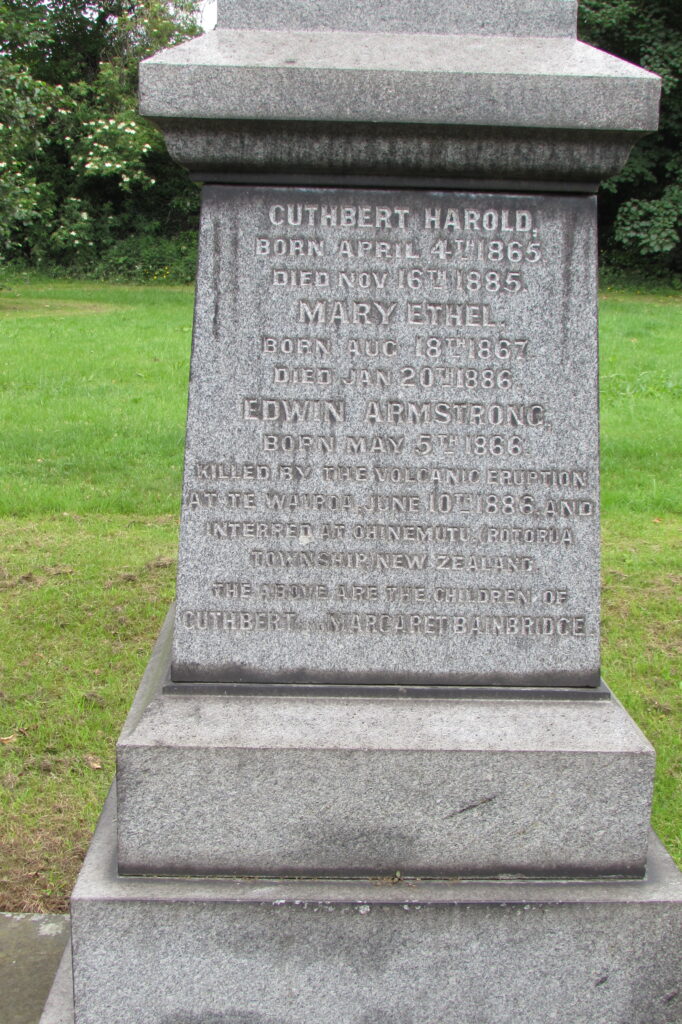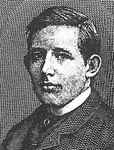SHOPKEEPER SUPREME, METHODIST

Situated in the Unconsecrated/East Section of Jesmond Old Cemetery.
Emerson Muschamp Bainbridge, founder of Bainbridge’s department store, was youngest of seven children born to Cuthbert Bainbridge and Mary Muschamp (whose family had married into the Emerson’s at an earlier date). Born at Eastgate, Weardale, where his father was a yeoman farmer, he was apprenticed at 13 to a Newcastle draper for five years. During the seven days annual holiday young Emerson usually walked the 30 miles back home – an energy that characterised his life.
After two year’s London experience following the end of his apprenticeship, Emerson returned to Newcastle to partner a woollen and linen draper in the new and fashionable Market Street where they were among the very first traders to adopt fixed price labelling rather than the customary haggling. Later innovations included the sale of ready-made clothes and in 1849 departmentalisation – allegedly the first shop to introduce this. In 1855 Emerson became sole proprietor and from then on his Market Street premises expanded until 1952, when the business was taken over by the John Lewis Partnership, though the name ‘Bainbridge’ was kept until recently. The premises are now in Eldon Square.

The family were staunch Methodists and always tried to deal fairly with both customer and employee. At a time when it was usual to work a 15-hour day, six days a week, with no half-day closing, Emerson allowed time off to staff as follows: ‘one evening a week for courting purposes and two if they go to prayer meetings regularly’.

Cuthbert Bainbridge, the first born son of Emerson Muschamp Bainbridge, was born in 1841. He married Margaret, nee Armstrong (born in 1843 in Manchester) in 1862 at the Wesleyan Methodist Chapel, Manchester. They had six children, Annie Edith, Cuthbert Harold, Edwin Armstrong, Mary Ethel, Emerson Percy and Walter Vasey. The death of Cuthbert, at the age of 32, was announced in The Newcastle Daily Chronicle, Monday, March 24, 1873, stating that, “we regret to announce the death of Mr. Cuthbert Bainbridge, of the firm Messrs. Bainbridge and Co., drapers, Market Street, Newcastle, which took place at his residence, Leazes Villa, about a quarter to eleven on Saturday forenoon. The deceased gentleman was in London on Wednesday week on business, and at night, whilst travelling homewards in the train, became unwell. At first, no danger was apprehended, but towards the close of the week the symptoms became serious, and he was attended by Drs. Lightfoot, Charlton and Nesham. His parents, who were in Italy, were telegraphed for, and they arrived on Saturday morning about five o’clock. The cause of death was typhus fever. The deceased, who was 32 years of age, has left a widow and six children. He was well known as a gentleman of exemplary character, and his loss will be deeply mourned by all who were acquainted with him, more especially the members of the Wesleyan body in this district, in connection with which he was a class leader. He took a deep interest in the Band of Hope, and was a speaker at the great demonstration held in the Town Hall, little more than a fortnight ago. He was one of the first and most zealous promoters of the Hospital Sunday movement, and in many good works was an indefatigable labourer. At Brunswick Place Chapel, where the deceased used to worship, the congregations yesterday morning and evening manifested profound feelings of sorrow, and at Park Road Chapel, the Rev. Peter McKenzie, in the course of the morning service, touchingly alluded to the solemn event.”
Margaret Bainbridge died on April 10th, 1877, aged 34, which left all six of her children now orphaned.

Some 12 years later, The Blyth Weekly, Saturday, November 28, 1885, reports that the new Wesleyan Chapel, in memory of the late Mr. Cuthbert Bainbridge, who was described as “a very active and influential member of the Wesleyan body”, was erected at Heaton Road, Byker, and opened by the Rev. Richard Roberts. The new building, known as the Cuthbert Bainbridge Memorial Methodist Church, whose architecture was described as “a very superior style, with a lecture hall and five vestries. The interior is spacious, well lighted and ventilated, with the accoustics being so well studied that the voice of the preacher is heard distinctly in every part”, cost £6,878 9s. 6d. to build, with Mr. E.M. Bainbridge paying £765 for the purchase of the land and Messrs. Bainbridge contributing £500 towards the cost of the building. The architects were Messrs. Sept. Oswald and Son, Newcastle, with the new building, capable of holding 900 people, replacing the old chapel on the corner of Shields Road and Edwin Street, Byker, which only held 350 people.

In terms of Cuthbert and Margaret’s children, three of their details are recorded on the same monument as their parents.

Cuthbert Harold Bainbridge, the first born son of Cuthbert and Margaret Bainbridge, was born on April 4th, 1865. I can’t find much on Cuthbert, other than he was a Bachelor when admitted to Dinsdale Park Asylum, Darlington, which advertised itself as “a private asylum for the quiet and harmless”. He was admitted on October 5th, 1885 and discharged on November 11th, 1885 and is recorded as dying of gun shot wounds in Dumfries five days later on November 16th, 1885, at the age of 20.
Mary Ethel Bainbridge was born on August 18th, 1867 and died on January 20th, 1886, aged 19, some two months or so after her brother Cuthbert. The records state, somewhat mysteriously, that Mary died of ‘decline’.
Edwin Armstrong Bainbridge, the second son of Cuthbert and Margaret, was born on May 5th, 1866, and has left an easier trail to follow in terms of his life story.

After some instruction at home, he attended a school at Darlington run by a Mr. Brooke, and in 1879 was sent to Leys School, Cambridge, under Dr. Moulton, where he distinguished himself in athletics, as well as by his conduct as a prefect, and his heartily dislike of all that was mean and dishonourable. In December 1884, he left the Leys, and after a short interval spent at home, he entered the employment of Messrs. Hitchcock, Williams and Co., of St. Paul’s Churchyard, London, where for the first time in his life, he felt the need of a God. Following the tragic deaths of his brother and sister in 1885, it was decided that Edwin should go on a long voyage in order to help with his mental health, which was to embrace Australia, Fiji, New Zealand and the United States. Accordingly, he sailed in January, 1886, in the steamboat Paramatta, but fate was to deal the Bainbridge family another blow, with Edwin losing his life during his stay in the Salt Lake district of New Zealand. The Morpeth Herald of Saturday, May 28, 1887, highlight a book written by T. Darlington, of St. John’s College, Cambridge, entitled ‘Memoir to Edwin Bainbridge, an old schoolfriend of Edwin. The memoir describes how Edwin Bainbridge, perished in the volcanic eruption which suddenly broke out in Mount Tarawera, New Zealand, on the 10th June, 1886, while on a tour for the benefit of his health, he being then only 20 years of age. At the outset, the author gives an account of the school days of the young Bainbridge, which “showed that at that early period he was quite a favourite with everyone with whom he came in contact, because of his gentle, amiable and unselfish disposition, and his high Christian character.” Of Edwin’s tour of the antipodes, the writer gives copious extracts from his letters and also from his diary, with the book containing a detailed description of the catastrophe, as seen by an eye witness, “it appeared that while the eruption was in operation, the party, including Edwin Bainbridge, took refuge in one of the rooms of McRea’s Hotel, To Wairoa, but sand, stones and mud continued to fall in such showers that they threatened every moment to bring down the building and bury all within. At this time of great suspense, when each one thought the next moment to be his last, Edwin Bainbridge pointed out to his companions the way of salvation. He offered up an earnest prayer to God, read a portion of scripture, and said a few words of comfort and encouragement, exhorting them, if they had not already done so, to give their hearts to God now; and if any of them should escape, to make it the turning point in their lives.” At this point, Edwin wrote in his diary “This is the most awful moment of my life. I cannot tell when I may be called upon to meet my God. I am thankful that I find his strength sufficient for me. We are under heavy falls of volcanic….”

At 06.00, it was decided to evacuate the doomed hotel and head to one of the native guide’s huts, but Edwin was killed by the collapse of the balcony of the McRea’s Hotel – all the others safely reached the hut and survived the terrible eruption.
Edwin is buried in Kauae Cemetery, Ngongotaha, near Rotorua. The obelisk memorial has a photograph of Edwin on the front and an inscription on the side. The Bainbridge family sent funds in order to establish a Methodist Church in Rotorua and, some 20 years later, the church was built and named the Bainbridge Memorial Church in memory of Edwin.

